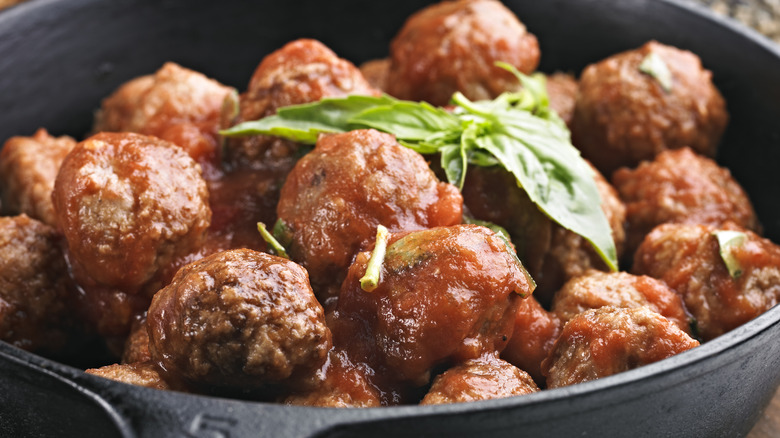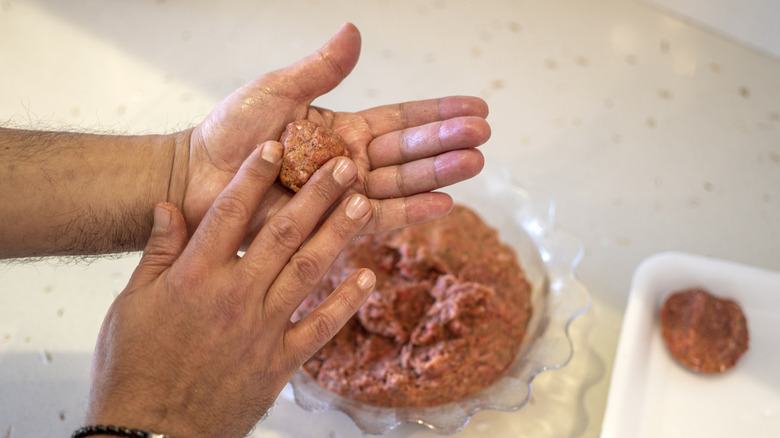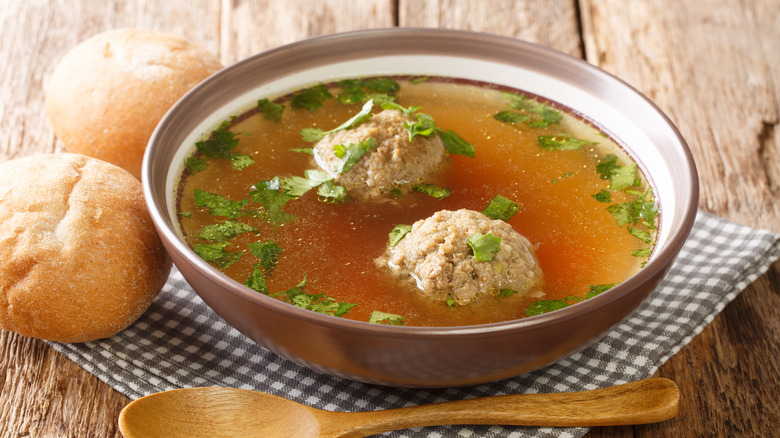What's The Best Meat-To-Fat Ratio For Meatballs?
Ask any group of chefs what the best blend of meats are for meatballs and you're bound to get a variety of opinions. They'll probably all agree, however, that a good spaghetti-worthy meatball is made with a blend of meats, usually beef, veal, and pork. Each meat is bringing a little something to the table. Beef is there for flavor and structure, pork is also for flavor as well as fat, and veal keeps the meatball tender and moist. If you're shopping for meatball supplies, and you want to make the mix yourself, you'll need to balance the fat ratios of each meat. While you don't need to break out the calculator at the meat counter to figure out the fat content of each meat, there are a few rules of thumb to follow depending on what the end-goal is for the meatballs: sauce or broth.
Meatballs made for tomato sauce need some structure and extra fat to keep them tender and tasty when they're up against the acidity in the sauce. If you're using a blend of meats, choose very lean ground beef, and fattier ground pork. If you're adding veal to the mix, which is typically pretty lean, you can choose a fattier beef or pork. If you're making meatballs for broth, use leaner meats because they don't need to cook as long, plus you don't want a lot of extra fat to accumulate in your broth.
Meatballs with tomato sauce
Meatballs are one of those recipes that seems deceptively easy. After all, they're just little bits of meat — how complicated could it be? Whenever a recipe has only a few ingredients, however, it's extra important to get them right, and if you want to make the best meatballs you can't just use any old ground meat.
If you're planning to make meatballs for tomato sauce, you'll need some extra fat to stand up to the acidity in the sauce, and to keep the meatballs juicy. Shoot for a meat blend that has either a half-and-half blend of ground beef and pork, or equal parts beef, pork, and veal. Ground pork is pretty fatty, and you can find it in the grocery store with ratios ranging from 80-to-20 (meat to fat) to as fatty as 60-to-40, and even 50-to-50, which will keep your meatballs juicy as they simmer in a tomato sauce. If you're using fairly fatty pork, choose leaner grinds of the other meats like 90-to-10 ground beef and 80-to-20 veal as the pork fat will do all the heavy lifting. Pork fat is much more neutral in flavor than beef fat, which is why it's the fat of choice for sausages and rendered into lard for cooking, and won't detract from the flavor profile of your meatballs.
Meatballs for broth
Meatballs that are destined for broth are a different breed than meatballs for tomato sauce. If you're making meatballs for a recipe like Italian wedding soup, or for punching up matzo ball soup, it's better to use meats like extra lean beef, veal, and chicken with very low fat ratios. Meatballs cook in broth very quickly, so they don't need a lot of fat to keep them juicy. Any extra fat in the meatballs will also eventually render out of the ball and into your broth, which will leave you with filmy fat deposits on top of your soup.
If you want to make meatballs for broth with a beef base, choose a blend that's very lean like 90-to-10 meat-to-fat, and try not to choose any veal that's got more fat than a 70-to-30 blend. Ground chicken and turkey are naturally very low in fat, and are typically pre-packaged so you can't choose the grind, but are great for making meatballs for broth and soup.
Fat ratios aren't too complicated once you know what you're looking for when you're out shopping for meatball supplies. But if you don't remember what the ratios are, you can also always look for a "meatloaf blend" at the grocery store, which usually has around an 80-to-20 blend of fat-to-meat with a mix of beef and pork (and sometimes veal), which will work just fine for most meatballs, no home blending necessary.


